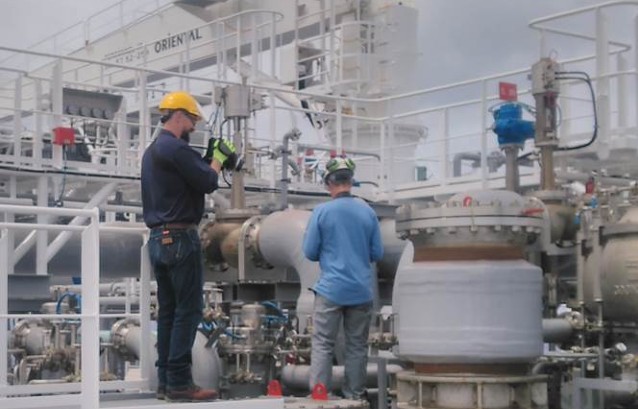Total methane and CO2 emissions from liquefied natural gas carriers (LNGs) measured for the first time
The study, led by Queen Mary’s Dr Paul Balcombe, provides important data as LNG imports are likely to grow substantially to reduce Europe’s reliance on Russian gas.

Dr Balcombe taking measurements onboard the Gaslog Galveston
The data improves the understanding of greenhouse gas emission profiles of LNG carriers to meet national and international climate targets and corporate climate strategies.
In 2021, a team of researchers led by Dr Balcombe took direct measurements onboard LNG carrier GasLog Galveston for a roundtrip voyage from Cheniere’s Corpus Christi liquefaction facility to a discharge port in Europe.
Their research covered all sources of methane and CO2 emissions, including engine exhausts, venting and fugitive emissions. The study also sheds light on the best methods to directly measure methane emissions from LNG carriers, for future studies or retrofitting on-board continuous emissions monitors.
Dr Paul Balcombe, Lecturer in Chemical Engineering and Renewable Energy at Queen Mary University of London, said:
“This study helps to fill a big data gap when it comes to methane emissions from LNG shipping. It’s vital that we understand what their emissions profile is at a time when LNG imports are likely to grow substantially to reduce Europe’s reliance on Russian gas.
This study is the first-of-a-kind to measure total methane emissions from engines aboard LNG carriers, including venting and fugitive emissions, but we need to do much more to get a representative sample of the approximately 600-strong LNG fleet. As well as these academic measurement studies, increased monitoring of emissions from engines, vents and fugitives would allow us to identify and implement effective reduction measures as hotspots are found."
The results and recommendations are published in the journal Environmental Science and Technology (American Chemical Society) and include:
- CO2 emissions were lower than other studies have assumed, while venting and fugitive emissions of methane were also extremely low.
- Uncombusted methane emissions from engine exhaust were in line with manufacturers’ test data, but higher than other studies due to higher methane slip from the generator (non-propulsion) engines.
- These engine methane slip emissions can be reduced drastically (as much as by half) by operating the engines at higher loads. The study notes that this was the Galveston’s second voyage, and multiple engines were used at lower loads for operational reasons, and that carriers often utilize engines at higher loads.
- The study recommends installation of methane emissions monitors on engine exhausts to monitor and report more accurate methane emissions estimates and to support methane mitigation operational practices.
Research paper: ‘Total methane and CO2 emissions from LNG carriers: the first primary measurements,’ Paul Balcombe, Dalia A. Heggoi, Matthew Harrison, in Environmental Science and Technology (American Chemical Society)


